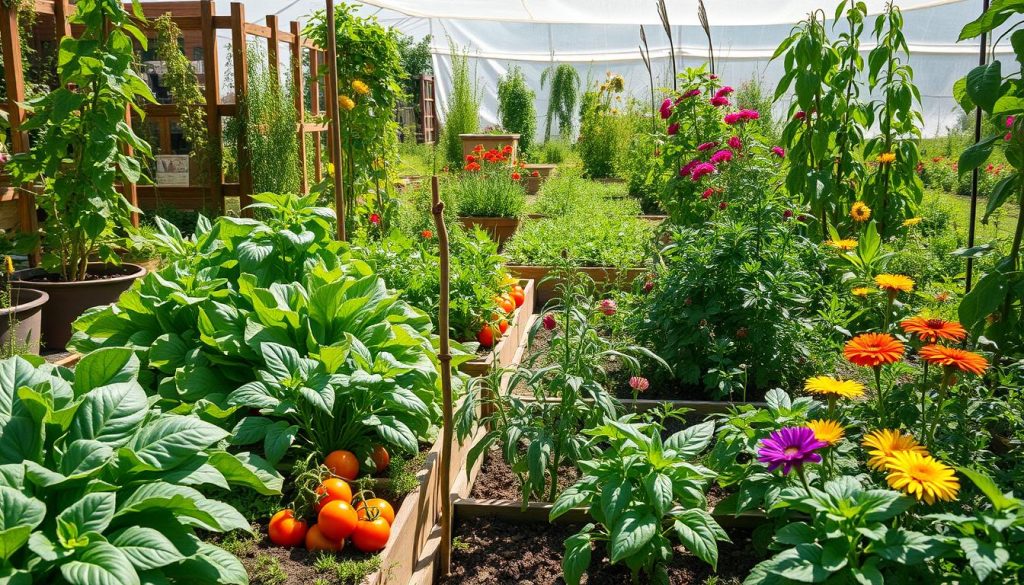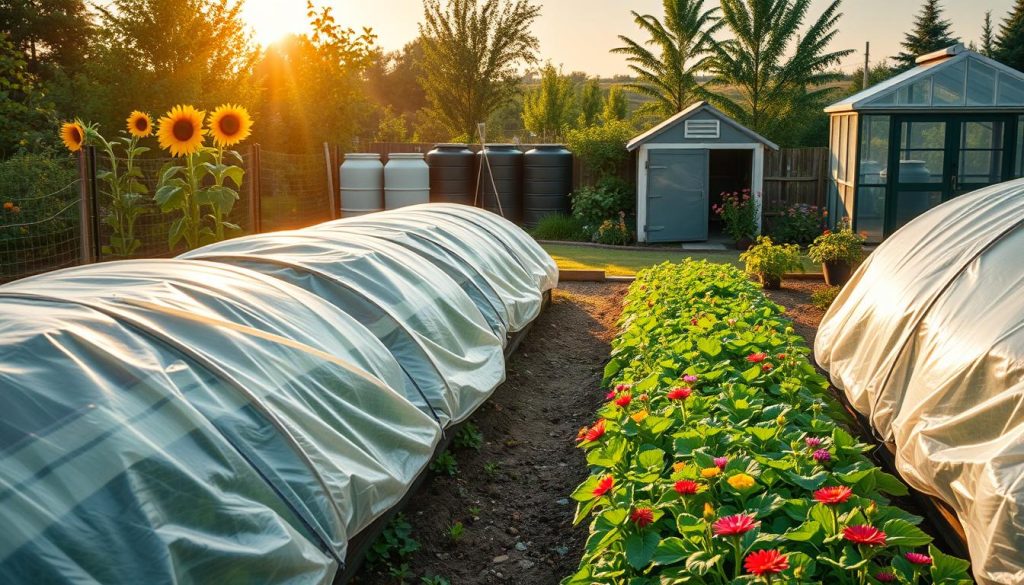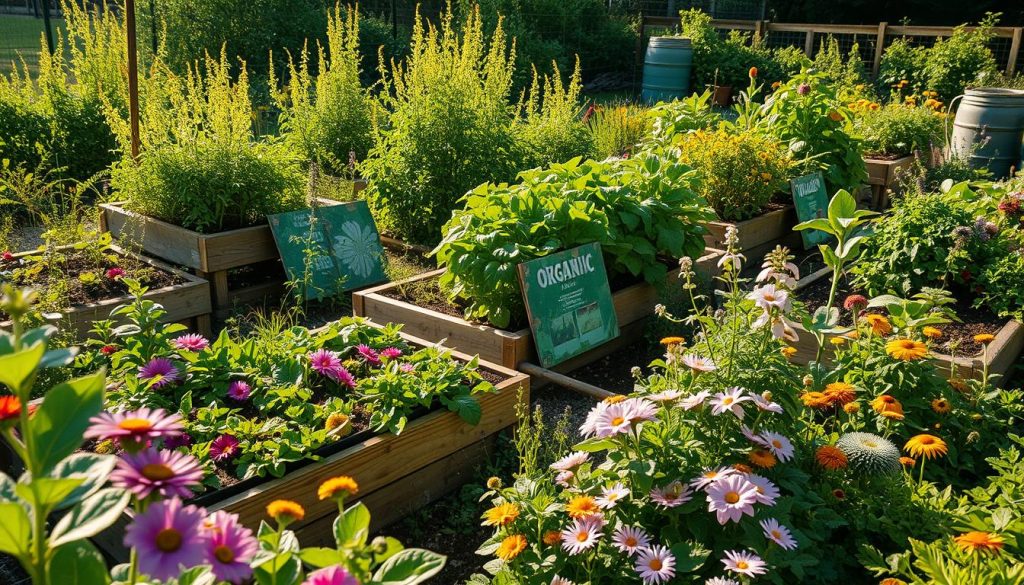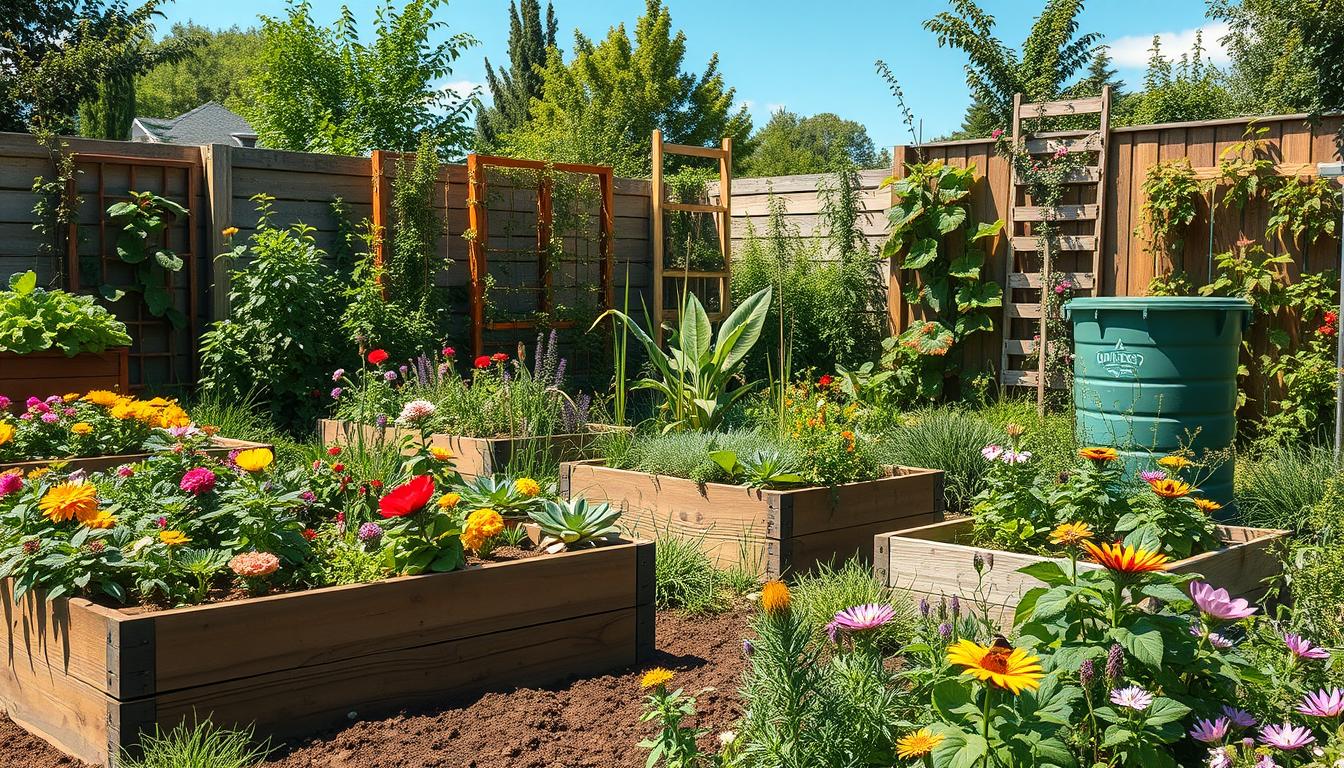As a gardener, I’m always searching for ways to enjoy fresh produce longer. Extending the growing season sustainably is a great way to do this. It’s easier than you might think. By using sustainable gardening tips and eco-friendly methods, I help create a sustainable food system.
This approach also reduces my need for industrial agriculture. Learning to extend your growing season sustainably makes your garden more environmentally friendly.
To start, understanding the value of sustainable gardening is key. It helps my garden and the environment. I’ll share my tips on extending the growing season, from picking the right plants to using season extension techniques.
Throughout, I’ll focus on sustainable gardening tips and eco-friendly methods.
Understanding My Local Climate
To extend the harvest season naturally, knowing your local climate is key. It helps decide the best planting and harvesting times. This ensures a fruitful and eco-friendly farming practice. Practices like crop rotation and soil conservation keep the soil healthy and prevent erosion.
Several factors are important when understanding your local climate. These include:
- Analyzing frost dates to determine the last frost date in the spring and the first frost date in the fall
- Recognizing microclimates, which are small areas with unique climate conditions
- Utilizing USDA plant hardiness zones to determine which plants are suitable for my area
By considering these factors, I can create a personalized plan. This plan helps extend the harvest season naturally and promotes sustainable farming. It keeps my garden healthy and productive, while also reducing environmental harm.
Understanding my local climate and using sustainable farming practices extend my growing season. This benefits my garden, the environment, and my community.
Choosing the Right Plants
To extend my growing season, I pick plants that love my local climate. I look for native and adaptable species, and seasonal varieties that fit my area. This way, my garden is diverse, thriving, and eco-friendly. It’s all about working with nature, not against it.
When picking plants, I think about their hardiness, growth, and how they can grow together. By choosing plants that get along, my garden becomes a balanced ecosystem. This means less need for harmful chemicals and more natural beauty.
Native and Adaptable Species
Native plants are perfect for my garden because they love the local weather and need less care. I’ve had great success with coneflowers, black-eyed susans, and native grasses. They’re not just pretty; they also feed and shelter local wildlife.
Seasonal Varieties for My Region
I also choose plants that match the seasons in my area. Tomatoes, peppers, and cucumbers do great in the summer. By picking varieties made for my region, I know they’ll grow well and give me a big harvest.

Companion Planting for Success
Companion planting is a big part of my gardening strategy. It helps plants grow well together and reduces the need for harmful chemicals. For example, marigolds keep nematodes away from tomatoes, and basil makes peppers taste better.
Implementing Season Extension Techniques
To extend my growing season, I’ve started using various techniques. These help protect my plants from frost and harsh weather. I use sustainable methods to reduce environmental impact and enjoy a longer season. Key aspects include using renewable energy and reducing water waste.
Effective techniques include cold frames, hoophouses, row covers, and mulching. These create a microclimate for plant growth, even in cold temperatures. By using these methods, I can grow more and for longer.
Cold Frames and Hoophouses
Cold frames and hoophouses use transparent materials to let sunlight in while keeping frost out. They help start seedlings early or extend the season for warm-season crops.
Row Covers for Added Protection
Row covers are lightweight, breathable fabrics that protect plants from frost and harsh weather. They work well with cold frames and hoophouses for extra protection.

Mulching to Retain Heat
Mulching keeps my garden warm and moist. Organic mulch, like straw or wood chips, helps. This is especially useful in colder climates where soil takes longer to warm up.
These season extension techniques let me grow more for longer while being sustainable. Extending the growing season requires a holistic approach, from seed to plate.
Practicing Organic Gardening Methods
To keep my garden healthy and thriving, I use organic gardening methods. This helps my plants and is better for the environment. I use compost and manure to improve soil health and reduce waste.
Using natural mulches and saving water are also key. These eco-friendly gardening methods help lower my garden’s environmental impact. Here are some strategies I follow:
- Enhancing soil health naturally through the use of compost and manure
- Using organic pest control methods to minimize harm to beneficial insects
- Introducing beneficial insects to my garden to promote a balanced ecosystem
By using these sustainable gardening tips, my garden is not only healthy but also helps the environment. 
Practicing organic gardening has greatly improved my garden’s health and productivity. I’m sure that with these methods, my garden will stay healthy and thriving for many years.
Implementing Water Conservation Strategies
To extend the harvest season naturally, it’s key to save water. This helps cut down on waste and lessens harm to the environment. Practices like crop rotation and soil care keep the soil healthy and prevent erosion.
There are many ways to save water in my garden. Some include:
- Rainwater harvesting techniques: collecting and storing rainwater for irrigation purposes
- Drip irrigation systems: delivering water directly to the roots of plants, reducing evaporation and runoff
- Mulching for moisture retention: using organic materials to retain soil moisture and reduce the need for frequent watering
Using these water-saving methods, I can make my garden more sustainable. This not only extends the harvest season but also supports eco-friendly farming. It keeps my garden healthy and reduces my impact on the environment.
As I keep using these strategies, my garden will grow stronger. It will be ready for the changing climate’s challenges. By choosing sustainable farming and extending the harvest season, I get a rich harvest. Plus, I help make the future greener.
Observing and Adjusting My Practices
Extending the growing season sustainably is a journey that needs constant attention. Keeping a garden journal helps me track my progress and learn from each season. This way, I can adjust my methods to fit the changing climate and stay eco-friendly.
Keeping a Garden Journal
Having a detailed garden journal is key to monitoring my sustainable gardening efforts. I write down notes on plant growth, weather, pest control, and how well my season extension works. This information helps me see where I can improve and make better choices for the next season.
Learning from Each Season
Every year, I learn new things that help me improve my gardening. I look at which plants did well, which methods were best, and where I can tweak things. By always learning and adjusting, I can make my growing season longer and greener.
Adapting to Climate Changes
As the climate changes, I need to adjust my gardening plans. I watch the weather and see how it affects my garden. This lets me change my plant choices, season extension methods, and water use. Being flexible helps my garden stay productive and strong, even with a changing climate.

